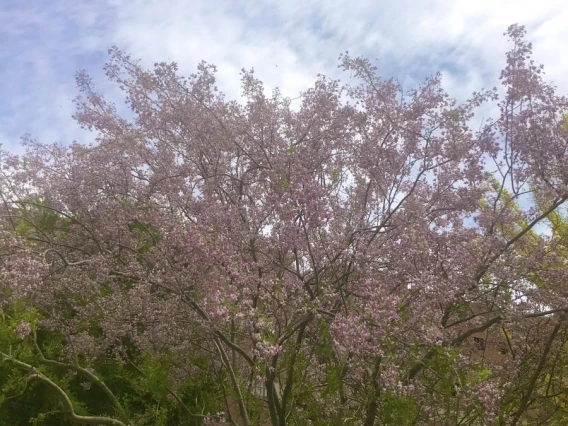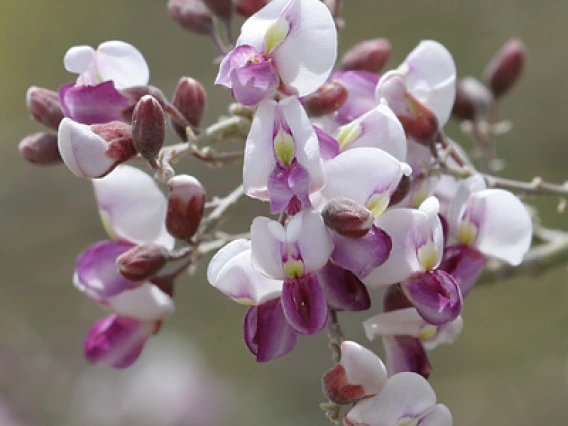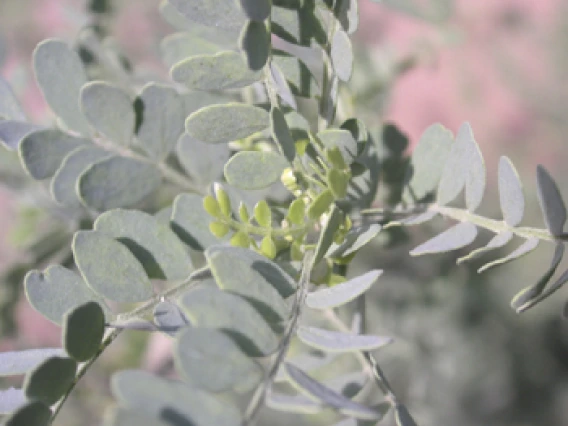


Common Names:
- English: Desert Ironwood
- Spanish: Tésota / Palo Fierro
- O’odham: Ho’idkam
Family: Fabaceae (pea/legume family) | Synonym: Leguminosae
Botanical Name: Olneya tesota
Rain Garden Zone: O. tesota thrives in the terrace rain garden zone, but may grow well in the top rain garden zone as well. The terrace zone is typically atop a terrace or on the bank of a basin or swale. These sites have more shallow, less-frequent, and more temporary pooling than in bottom zone. The top zone is the area beside, but not in, the basin where plant root crowns stay dry; but where roots can access water harvested below in the basin. This location is the driest and warmest of the three zones.

Reproduced with permission from "Rainwater Harvesting for Drylands and Beyond" by Brad Lancaster, HarvestingRainwater.com
Flowering Season: April - May
Harvest Seasons:
- Green Seed: May-June
- Ripe Dry Seed: June-August
Harvesting Techniques: Ironwood flowers and seeds are edible. Although both fresh and dry pods can be eaten, dry pods are most often harvested as they are easier to store and process. When the pods dry in June through August, they will be a light beige color. When plucking pods from the branches, be careful not to damage the tree branches. To assist with reaching pods on higher branches, use a harvest hoe or ladder. Always pick pods off of the tree rather than from the ground to avoid illness. As with everything, responsibly harvest only what you will be able to use.
Planting Season: Monsoon
Landscape Cultivation: Seed scarification is not needed for planting--plant the pods of the desert ironwood in places that are frost-free, as it is somewhat intolerant to freezing temperatures.
Characteristics: Desert ironwood is an evergreen tree that can grow up to 35 feet tall, making it the tallest-growing tree in the Sonoran desert. When in bloom, the tree has purple pea-shaped flowers, and when it is fruiting the tree has 5-6cm long, light brown bean pods. The bark begins smooth and gray and gradually becomes a darker green-brown with a more shredded appearance. Small hairs cover the leaves and twigs to protect from sun damage. Ironwood acquired its name from having hard and dense wood, the hardest wood of the desert regions. Ironwood is considered a good indicator of places that citrus trees will grow, since they both have similar frost-intolerance.
Ecological Benefits: Ironwood tree canopies provide micro-climates for other desert plants to grow within. Not only do these trees offer shading for the plants, but they can also provide key nutrients. The roots, in conjunction with mycorrhizal fungi and bacteria, fix nitrogen in the soil. This interaction improves the nutrition of the soil which benefits the ironwood as well as the other plants growing within its rootzone. Large and small mammals take refuge beneath the canopy of the ironwood which, when unpruned, creates a bubble-like canopy around the trunk. Ironwood is home to nesting birds and attracts pollinators with its bright, and highly fragrant flowers.
Practical Uses:
- Food - Desert ironwood is a key food source of native Sonoran people and animals. Both the flowers and the bean pods can be harvested for food. Young green ironwood seeds can be harvested in early summer, removed from the pod, and eaten fresh. These can be added fresh to salads and salsas, and can be used much like peas in other recipes. Ripe, dry seeds can be harvested in late summer and stored. Mature seeds can be dried and ground into a flour or soaked and sprouted and used in recipes. Seeds from the ironwood are a good source of protein and other vitamins, and are gluten-free. Soaking or blanching seeds may remove an initial bitter aftertaste.
- Domestic Animal Uses - Ironwood seeds can be dried, ground, and used to feed chickens and goats. Animals can also graze on the foliage of the tree.
- Other Uses - Ironwood has the strongest and densest wood in all of the desert region. Because of the dense wood, it is extremely hot when used as firewood. Additionally, ironwood has traditionally been used as medicine, shelter, and for tanning hides.
References:
- Desert Harvesters. (2018). Eat mesquite and more: a cookbook for Sonoran desert foods and living. Tucson, AZ. RainSource Press.
- Hodgson, W. C. (2001). Food plants of the Sonoran desert. Tucson, AZ. University of Arizona Press.
- Lancaster, B. (2019) Rainwater harvesting for drylands and beyond, 3rd edition. Tucson, AZ. RainSource Press.
For more information on this plant, see the Campus Arboretum species description pages.
Go to the next tour stop: desert oregano or Return to the main Dunbar Spring tour page

